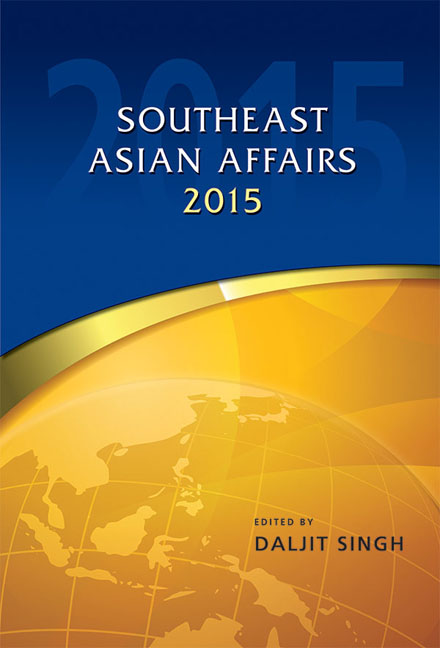Thailand in 2014: The Trouble with Magic Swords
from THAILAND
Published online by Cambridge University Press: 19 May 2017
Summary
For Thais, 2014 could be divided into two distinct periods: pre-coup, and postcoup. Before 22 May, Thailand was chaotic; after 22 May, outwardly much more orderly. However, orderly at what price? During 2014, Thailand's often contentious politics reached levels of conflict arguably not seen since the 1970s. Summarizing what happened is quite straightforward, but characterizing the conflict is more tricky. Superficially, there was a showdown between two rival power networks: the network aligned with former Prime Minister Thaksin Shinawatra (including his sister Yingluck, the Pheu Thai Party, the Red Shirt movement, elements of the business community, and the police) and the old power elite network aligned with the military (and including the palace, the Democrat Party, much of the bureaucracy, and the various “post-Yellow” movements). In this showdown, the military and their allies defeated the pro- Thaksin network by force, and then sought to consolidate their victory through lasting new political arrangements.
This interpretation assumes that the military and the Democrat Party were fast and firm friends with a common agenda. Another, and more troubling, possibility is that while Thaksin was especially disliked, the military harboured a deep distrust of all elected politicians, and has been profoundly unimpressed by the performance of the Democrats in recent years. In other words, the goal of the military is the “depoliticization” of Thai life, the creation of a public sphere in which contentious debates are permanently suppressed. Since this goal was unlikely be accomplished, the junta may have been setting itself up to fail.
Restart Thailand?
Following a troubling attempt by her administration to push an unpopular amnesty bill through Parliament, Yingluck Shinawatra was confronted by a wave of street protests that forced her to dissolve Parliament in early December 2013.2 The rallies peaked on 13 January 2014, when the anti-Thaksin movement attempted “Bangkok Shutdown” at eleven key locations across the city. At their height in mid-January, the protests led by the People's Democratic Reform Committee (PDRC) mobilized hundreds of thousands of people; at their nadir, by late April, they probably comprised no more than a few thousand. The grouping popularly referred to as the PDRC was a repositioning or regrouping of a range of organizations that had long been discontented with Thaksin and his political machine.
- Type
- Chapter
- Information
- Southeast Asian Affairs 2015 , pp. 337 - 358Publisher: ISEAS–Yusof Ishak InstitutePrint publication year: 2015

